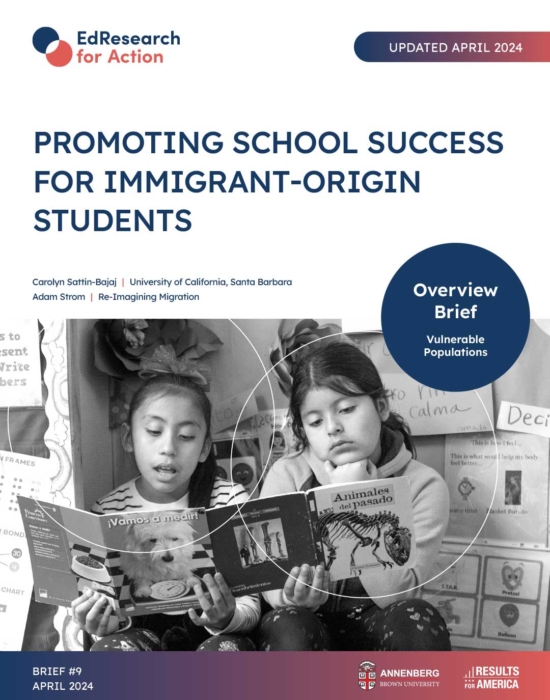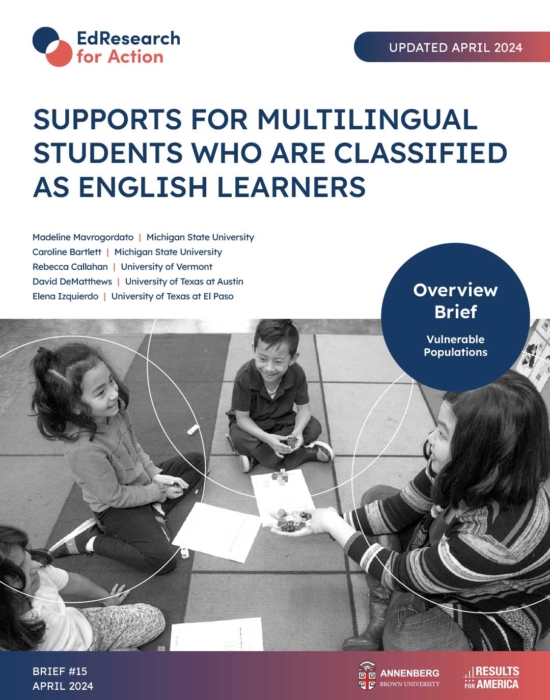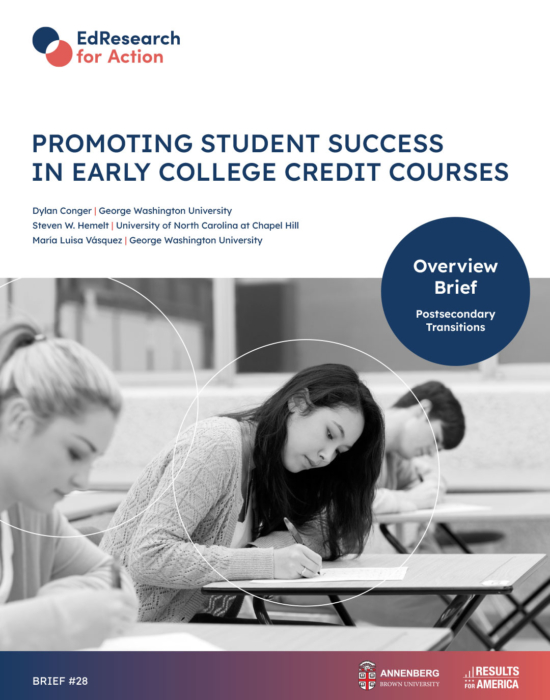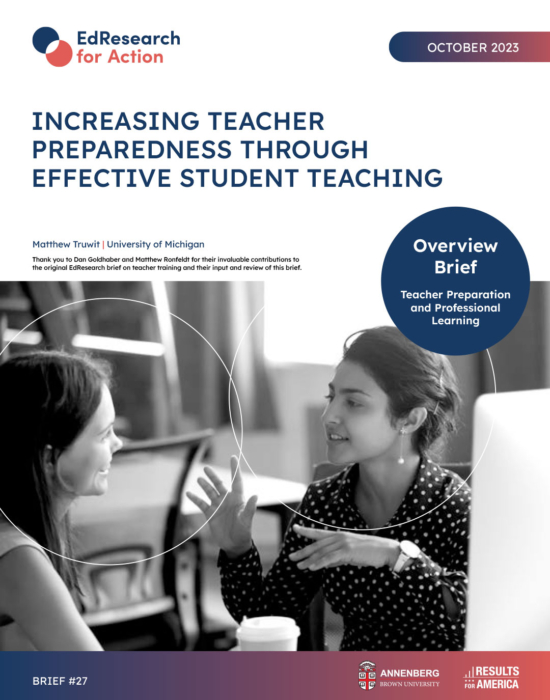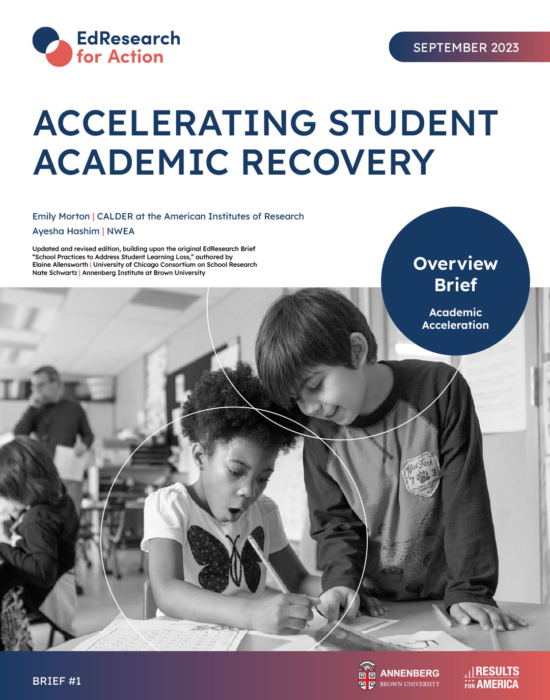SUPPORTS FOR MULTILINGUAL STUDENTS WHO ARE CLASSIFIED AS ENGLISH LEARNERS
The EdResearch for Action Research Overview Series summarizes the research on key topics to provide K-12 education decision makers and advocates with an evidence base to ground discussions about how to best serve students. Authors – leading experts from across the field of education research – are charged with highlighting key findings from research that provide concrete, strategic insight on persistent challenges sourced from district and state leaders.
Madeline Mavrogordato | Michigan State University
Caroline Bartlett | Michigan State University
Rebecca Callahan | The University of Vermont
David DeMatthews | The University of Texas at Austin
Elena Izquierdo | The University of Texas, El Paso
April 2024 | Brief No. 15
Central Question
What research-based practices can district and school leaders use to support the academic success and linguistic development of multilingual students classified as English Learners (ML-ELs)?
A note on terminology: In this research brief, the authors use the term “multilingual student classified as English learner” (ML-EL). This decision is based on a desire to strike a balance between an asset-based approach (emphasizing multilingualism) and specificity (highlighting those entitled to language development support services). We chose this term over alternatives like “multilingual learner” or “emergent bilingual” due to its ability to precisely identify the subgroup eligible for English language support services, avoiding ambiguity and encompassing only those classified as ELs under federal law. We believe that ML-EL effectively captures the positive and strengths-oriented perspective while allowing for accurate analysis of educational challenges and disparities faced by this group. A deeper discussion on terminology can be found in a forthcoming chapter on ML-EL students in the second volume of the AERA Handbook of Education Policy Research.
Key Insights
Breaking Down the Issue
- ML-ELs tend to score lower than their non-ML-EL peers on standardized tests. However, interpreting this gap is complicated by the fact that these tests are typically administered in English, and high-scoring students who transition out of EL status are excluded.
- Principal and teacher preparation programs often inadequately train educators on effective pedagogy, program creation, and resource allocation to meet the needs of ML-EL students.
- Many schools struggle to communicate effectively with ML-EL students’ families, resulting in lower participation and communication levels for non- English-speaking parents.
- The lack of explicit federal guidance and limited federal funding results in uneven and often inadequate services for ML-ELs, which impedes their development of English proficiency and exacerbates educational disparities.
- Districts with high ML-EL populations tend to face persistent underfunding, hindering their ability to provide necessary resources and support programs for ML-EL students.
- The vast majority of ML-EL students are not being educated through bilingual and dual language models, despite evidence that these programs are more effective than English-only instruction.
Evidence-Based Practices
- Bilingual program models, particularly dual language approaches, show higher achievement for both ML-ELs and non-ELs compared to English-only programs.
- Differentiated language development services are necessary to meet the needs of ML-ELs with varying language proficiency levels and educational backgrounds.
- Programs that consistently engage parents in their native languages find positive effects on parent participation and student attendance.
- Instructional resources and technology designed to integrate language development and grade-level content learning have demonstrated effectiveness in recent studies.
- Emphasizing pedagogy that values students’ backgrounds and providing extended learning opportunities can positively influence ML-EL students’ engagement, achievement, and sense of belonging.
- Ongoing collaboration between ML-EL and general education teachers, facilitated by district and school leadership, improves teaching practices and equity for ML-EL students.
Practices to Avoid
- A one-size-fits-all approach to ML-EL education assumes that all EL students have the same educational needs, thereby limiting many students’ opportunities to engage with rigorous content and develop their language skills.
- Separating ML-ELs from their content courses for targeted English language instruction hinders their academic progress and negatively impacts their self-perception by limiting their exposure to core academic content.
- Communicating effectively with ML-EL students and their families involves more than translations; it requires contextual explanations about the U.S. school system and detailed demonstrations of classroom activities and academic terms.
- Grade retention has been found to impede academic and language development for ML-EL students, rather than helping them catch up as intended.
- As the demand for bilingual and dual language programs increases among Englishdominant families, it is critical that these programs protect access for ML-EL students and the primary focus continues to be advancing linguistic equity.
Breaking Down the Issue
What do we know about the ML-EL student population?
ML-EL students are the fastest-growing sub-population in grades K-12 and are entitled to English language development instruction that will allow meaningful access to academic content. Today, 10% of public school students, about 5 million children, are classified as ML-ELs, an increase from 7% in 2000.
The majority of ML_ELs were born in the United States: 85% of ML-EL students in pre-kindergarten to 5th grade are U.S.-born, as are 62% of ML-ELs in 6th to 12th grade. Historically, ML-ELs have been concentrated in a handful of traditional immigrant gateway states (especially California, Texas, and New York) and large urban school districts. Between 2010 and 2020, however, states such as Louisiana, Mississippi, Kentucky, and Rhode Island have seen the largest growth in the proportion of ML-EL students served. In total, the ML-EL student population has increased in 41 states since 2010, and more than three-quarters of public schools now serve ML-EL students.
The majority of ML-ELs in the U.S., over 75%, speak Spanish, yet the overall ML-EL student body encompasses speakers of more than 400 languages. Ethnically and racially, this group is predominantly Hispanic at 77%, followed by Asian at 10%, White at 6%, and Black at 4%.
The levels of English proficiency among ML-ELs vary considerably. Some students have advanced skills in English, while others require more intensive language support. Elementary schools have a higher percentage of ML-ELs than middle or high schools, likely because many students achieve sufficient English proficiency and no longer require ML-EL resources as they continue their education.
How do ML-EL students perform in K-12 education, and what challenges do they face?
ML-ELs tend to score lower than their non-ML-EL peers on standardized tests. However, interpreting this gap is complicated by the fact that these tests are typically administered in English, and high-scoring students who transition out of EL status are excluded.
- ML-ELs often score below their non-EL peers on standardized tests. For example, 29% of 8th-grade non-ELs scored at the “proficient” level on the 2022 NAEP mathematics assessment, compared to only 4% of ML-ELs.
- However, the often-cited achievement gap between ML-EL and non-EL students is difficult to interpret for two key reasons: 1) standardized tests are often given in English (and students who are in the process of acquiring English proficiency tend to have greater difficulty with these assessments than their peers who are English proficient); 2) The EL-classified subgroup of multilingual students is inherently unstable over time; students acquire English proficiency, which often corresponds with greater academic success, they exit EL status.
- ML-ELs face meaningful educational opportunity gaps, particularly as they advance through school. Compared to their non-ML-EL peers, ML-ELs are less likely to be enrolled in honors and advanced coursework (and their participation in these classes tends to decline as they get older), and they are nearly 20 percentage points less likely to complete high school.
- ML-ELs are often tracked into less rigorous courses with less experienced teachers, compared to their non-EL peers, particularly in high school. Further, teachers may also hold lower expectations of ML-EL students compared to non-ELs.
- Schools serving larger populations of ML-ELs are less likely to offer programs for gifted students. When they do offer such programs, they are less likely to include ML-ELs than other students.
Principal and teacher preparation programs often inadequately train educators on effective pedagogy, program creation, and resource allocation to meet the needs of ML-EL students.
- Over 67% of the nation’s teachers have at least one ML-EL in their class, but only 48% of those teachers have taken a course focused on instruction for ML-ELs. Further, only 10% are certified to teach English as a second language, highlighting a significant gap in the preparation of teachers to effectively support ML-EL students.
- Many teacher preparation programs provide little to no instruction on how to best meet the needs of ML-EL students, leaving new teachers unprepared to design and implement high-quality lessons, assess and monitor progress, co-teach, co-plan, and identify digital learning resources tailored to ML-EL students.
- School leaders also often lack adequate preparation to address the unique needs of ML-EL students, limiting their ability to shape policies, allocate resources, and set priorities effectively in schools with diverse linguistic backgrounds.
Many schools struggle to communicate effectively with ML-EL students’ families, resulting in lower participation and communication levels for non-English-speaking parents.
- ML-ELs’ families tend to hold high academic expectations for their children and place great value on education. However, cultural and linguistic barriers often make it difficult for them to be involved in their children’s schools in traditional ways.
- Schools are legally required to provide interpretation and translation services for families of ML-ELs, but many schools struggle to provide adequate services.
- Communication barriers make it more challenging for the parents of ML-EL students to engage in their children’s education. Parents who do not speak English at home report being less likely than other parents to receive written communication from school, participate in parent-teacher conferences, and volunteer at their child’s school.
The lack of explicit federal guidance and limited federal funding results in uneven and often inadequate services for ML-ELs, which impedes their development of English proficiency and exacerbates educational disparities.
- The Every Student Succeeds Act requires states to establish standardized protocols to determine which students are eligible for ML-EL services and when they no longer need them. However, the law gives states considerable leeway as to the specific protocols they can choose. As a result, educational supports and services for ML-EL students vary widely from state to state and even among districts and schools within the same state.
- Federal Title III funds to support ML-EL students are earmarked to provide supplemental services, but funding has remained flat even as the national EL population has rapidly grown. Many states provide additional funding for schools serving ELs, but the amount of funding varies widely across states, exacerbating between-state differences in the resources available to ELs.
Districts with high ML-EL populations tend to face persistent underfunding, hindering their ability to provide necessary resources and support programs for ML-EL students.
- Effective programs for ML-EL students, including linguistic assessment, hiring qualified staff, and providing high-quality instruction, tend to be resource-intensive. Despite supplemental funding from the federal and (most) state governments, districts report that existing funding levels are insufficient to meet the challenges they face.
- ML-EL students are much more likely to attend under-resourced schools than their native-English-speaking counterparts, compounding funding inequities.
- Not only do programs for ML-EL students tend to be underfunded to begin with, but in cases where existing ML-EL funds have been diverted to other uses (e.g., to make up for budget shortfalls during financial downturns), districts have neglected to restore those funds later on, further exacerbating existing inequities in educational access.
The vast majority of ML-EL students are not being educated through bilingual and dual language models, despite evidence that these programs are more effective than English-only instruction.
- Across the U.S., less than 20% of ML-EL students are educated through bilingual and dual language approaches, even though, the medium- and long-term, ML-ELs in bilingual education programs demonstrate higher rates of English proficiency and higher academic achievement than their peers in English-only programs.
- Bilingual and dual language programs have been proven to promote academic achievement, linguistic proficiency, and cultural competency by valuing and applying ML-EL students’ home languages as a foundation for learning.
- Despite these research findings to the contrary, proponents of English-only programs argue that students will learn English faster if they are immersed in the language.
One of the challenges in maintaining and growing dual language programs is the shortage of bilingual teachers. In California, for example, there is only one certified bilingual teacher for Spanish speakers available for every 240 Spanish-speaking students.
Evidence-Based Practices
Bilingual program models, particularly dual language approaches, show higher achievement for both ML-ELs and non-ELs compared to English-only programs.
- The vast majority of schools deliver English-dominant instruction to ML-ELs, such as pull-out or push-in strategies. In pull-out instruction, ML-EL students are separated from their content-area class to focus on English instruction. Under push-in, a teacher certified to work with ML-EL students supports them within their content-area class. Although push-in strategies are typically more effective than pull-out, the quality of instruction varies and may leave the general education teacher underprepared to meet ML-EL students’ needs.
- Bilingual programs, especially dual language education, have gained popularity over the past decade. When implemented properly, these programs bring together ML-ELs and non-ELs with the aim of making all students proficient in two languages. They deliberately create links between languages to achieve biliteracy throughout the educational content. Both ML-ELs and non-ELs act as models for their first language while they learn a second language, enhancing cross-linguistic understanding and equity.
- Students in dual language programs, regardless of their native language, often outperform their peers in English-only programs. Additionally, research has shown that ML-ELs enrolled in bilingual programs often achieve higher scores in reading and math and have lower dropout rates. This advantage becomes even more apparent when their academic progress is monitored over an extended period.
Differentiated language development services are necessary to meet the needs of ML-ELs with varying language proficiency levels and educational backgrounds.
- Newcomer ML-ELs and Long-term ML-ELs are often served through a one-size-fits-all approach despite their varying language proficiency levels and educational backgrounds.
- Newcomer ML-ELs have been in U.S. schools for fewer than three years and often have unique needs related to immigration experiences and adjustment to a new country and new schools. More school districts, such as Houston Independent School District in Texas, are adopting newcomer academies that provide temporary support for secondary newcomer students as they transition to U.S. schools and culture.
- Long-term ML-ELs have been identified as ML-EL for more than five years, often due to weak English language development programs or experiencing a narrowed curriculum due to their ML-EL status. These students are less likely to graduate high school and tend to have lower test scores than their peers. Individualized learning plans may be helpful in improving services for long-term ML-ELs given their varying needs. In addition, content-area teachers can provide linguistic scaffolds and supports to help long-term ML-ELs reach their full potential.
Programs that consistently engage parents in their native languages find positive effects on parent participation and student attendance.
- Embracing the cultural and linguistic assets of ML-EL students and encouraging families to draw upon their native language can promote ML-EL students’ academic success not only in their native language but in English as well, since higher-order language comprehension and literacy skills transfer from one language to another. A growing set of online learning resources is readily available to families in multiple languages. For Spanish-speaking families in particular, there are high-quality educational materials online including textbooks and videos to promote bilingualism.
- A recent experiment examined the impact of sending six distinct mailers, written in the families’ native language, emphasizing the connection between good attendance and grade-based learning outcomes to parents of high-absence students. The study found attendance increased by 15% across all students, and this effect was more than twice the size for ML-EL students compared to native-English-speaking students. The total cost of the intervention was $5.68 per student per year.
- Consistent family-friendly communication (including text messages) with ML-EL students and families in their home language may increase in-home support on assignments and improve family-school connections. For example, the Santa Barbara Unified School District formed a parents’ advisory committee that makes recommendations to the school board for improving ML-ELs’ academic experiences.
Instructional resources and technology designed to integrate language development and grade-level content learning have demonstrated effectiveness in recent studies.
- A recent study shows that ML-ELs who attend schools that have instructional materials explicitly designed to develop English language proficiency outperform their peers who attend schools that do not invest in such curricular materials.
- Translations, eBooks, intentional vocabulary development, and the use of definitions and cognates can enhance language development and allow ML-ELs to access grade-level lessons.
- Digital learning resources specifically designed for ML-EL students allow them to practice and apply all language modalities (e.g., listening, speaking, reading, writing) across content areas.
Emphasizing pedagogy that values students’ backgrounds and providing extended learning opportunities can positively influence ML-EL students’ engagement, achievement, and sense of belonging.
- Implementing culturally responsive pedagogy, such as learning to correctly pronounce students’ names and incorporating students’ cultures into classroom instruction, shows that educators value ML-EL students’ cultural backgrounds. This positively influences academic engagement, achievement, and a sense of belonging.
- Increasing opportunities to work one-on-one or in small groups with teachers, paraprofessionals, or tutors in virtual settings can provide an additional boost for ML-EL students. Small groups should be intentionally designed to include specific ML-EL students with a common learning need. For example, one group of ML-EL students may need assistance with foundational reading skills, whereas another group may have a strong literacy background in their native language and need to focus more on transferring those skills into English.
- Extended learning time outside of regular school hours or during the summer is especially helpful to ML-EL students. For example, Center City Public Charter Schools use Title III funds to operate ESL After the Bell, a two-hour after-school program that uses project-based and service learning strategies aligned with both WIDA and Common Core State Standards to develop students’ content knowledge while acquiring English proficiency.
- After-school programs (such as “reading buddies“) that focus on building connections can allow ML-ELs of different ages to connect, build community, mentor and be mentored, and generally feel welcome at school. These programs are especially beneficial for newcomer ML-ELs.
Ongoing collaboration between ML-EL and general education teachers, facilitated by district and school leadership, improves teaching practices and equity for ML-EL students.
- Research demonstrates the importance of creating opportunities for general educators and ML-EL educators to work collaboratively to improve teaching practices and promote equity for ML-EL students.
- District and school leadership can establish norms around collaboration between ESL and general education teachers by allocating specific co-planning time and setting clear co-teaching expectations.
- Establishing a culture that encourages shared responsibility for ML-EL students’ learning and positions every teacher as a language teacher can break down silos between general education and ML-EL teachers.
Strategies to Avoid
A one-size-fits-all approach to ML-EL education assumes that all EL students have the same educational needs, thereby limiting many students’ opportunities to engage with rigorous content and develop their language skills.
- ML-EL services tend to be provided in a homogeneous way that does not take into account that ML-EL students are a diverse group with varying levels of English proficiency, different educational histories, and a range of academic strengths and challenges. This can create barriers to learning due to inadequate opportunities to engage with rigorous academic content and language-rich curricular settings.
- Differentiated pedagogy based on students’ individual needs (e.g., English proficiency level, academic needs, time in ML-EL status, and grade level) is more effective at improving students’ outcomes.
Separating ML-ELs from their content courses for targeted English language instruction hinders their academic progress and negatively impacts their self-perception by limiting their exposure to core academic content.
- Although it is common practice to separate ML-EL students from their English-speaking peers to support language development, this practice has not been proven to benefit students. This research suggests that the potential advantages of specialized language support may be offset by the benefits of interaction with fluent English speakers.
- When ML-ELs are segregated for language development instruction, they are often removed from core academic content area courses such as math or English language arts. This practice can delay their graduation and academic progress, and produce negative self-concepts.
Communicating effectively with ML-EL students and their families involves more than translations; it requires contextual explanations about the U.S. school system and detailed demonstrations of classroom activities and academic terms.
- If family members are unfamiliar with the U.S. school system, then it may not be effective simply to provide them with a word-for-word translation of memos, emails, and other messages from the school. To fully understand those messages, family members may need more background information and explanations about the norms and routines of life in U.S. schools (everything from the need to sign permission slips to the purpose of parent-teacher conferences and the function of the school board).
- Similarly, teachers cannot assume that students understand instructions and assignments simply because they’ve been translated for them. Rather, teachers may also need to demonstrate and model classroom activities and explain academic language and content-area terminology that many native English speakers already know. Some online resources are designed to help ML-EL students pick up the background knowledge and vocabulary needed to make sense of grade-level academic content.
Communicating effectively with ML-EL students and their families involves more than translations; it requires contextual explanations about the U.S. school system and detailed demonstrations of classroom activities and academic terms.
- If family members are unfamiliar with the U.S. school system, then it may not be effective simply to provide them with a word-for-word translation of memos, emails, and other messages from the school. To fully understand those messages, family members may need more background information and explanations about the norms and routines of life in U.S. schools (everything from the need to sign permission slips to the purpose of parent-teacher conferences and the function of the school board).
- Similarly, teachers cannot assume that students understand instructions and assignments simply because they’ve been translated for them. Rather, teachers may also need to demonstrate and model classroom activities and explain academic language and content-area terminology that many native English speakers already know. Some online resources are designed to help ML-EL students pick up the background knowledge and vocabulary needed to make sense of grade-level academic content.
Grade retention has been found to impede academic and language development for ML-EL students, rather than helping them catch up as intended.
- A study that investigated the effects of grade retention on language learning outcomes (reading, listening, and writing) for ML-ELs over a seven-year period found that students who were promoted each year achieved higher English proficiency levels across all three domains compared to their retained peers.
- Another study identified grade retention as a significant risk factor for EL students becoming long-term English learners (students who do not reclassify as English proficient after the first five years of schooling).
- The authors of a recent study claim to have shown that Florida’s grade retention policies have benefited ML-EL students. But in fact, their research does not prove that retention itself is the reason they find improved student outcomes. When students were retained, they were also (1) enrolled in summer school, (2) provided with 90 minutes of daily reading instruction, (3) placed in classes with particularly effective teachers, and (4) given an individualized academic improvement plan, any or all of which could have influenced the improved outcomes. Given these additional resources, there is no reason to conclude that grade retention made a positive contribution.
As the demand for bilingual and dual language programs increases among English-dominant families, it is critical that these programs protect access for ML-EL students and the primary focus continues to be advancing linguistic equity.
- The increasing demand from English-dominant families poses a risk of shifting the programs’ priorities away from ML-ELs—who are the primary beneficiaries—towards serving as language enrichment opportunities for English-dominant students. In some areas, ML-ELs are increasingly being pushed out of dual-language programs, driven by pressures from local gentrification and the high demand from English-dominant families.
- Gentrification of bilingual education can marginalize ML-EL students, as resources may be redirected towards English-dominant students, or ML-EL students themselves are used as resources to help English-dominant students acquire a second language. This process can negatively impact the original goals of bilingual programs to promote linguistic and cultural inclusivity.

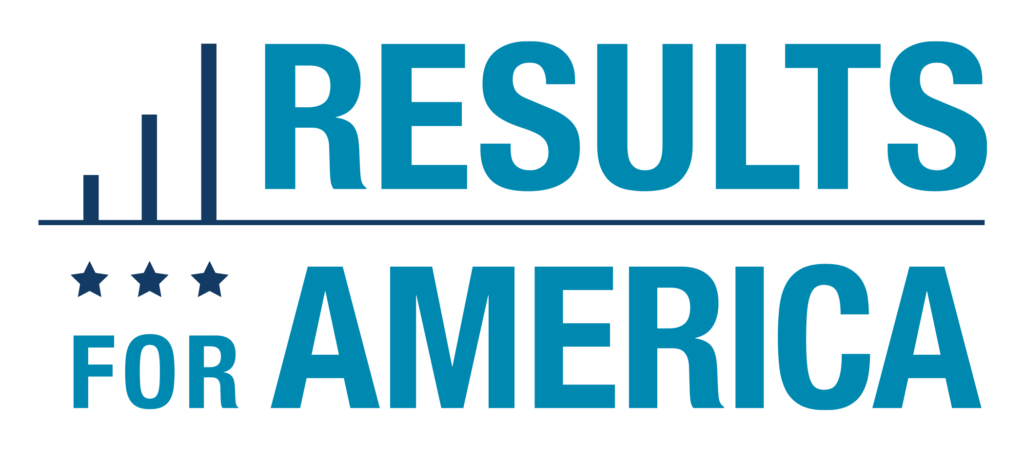



Funding for this research was provided by the Bill & Melinda Gates Foundation. The findings and conclusions contained within are those of the authors and do not necessarily reflect positions or policies of the foundation.

